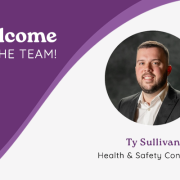I want to talk about a few different things today. One of the things that we’re encountering in the state of New Hampshire as the economy gets tighter and tighter with available workforce is just that. What do you do when you hire new people and how can you guarantee from a safety health standpoint that they’re going to fit into your company and not become a safety and health liability?
We exercise a practice in our own company that we call onboarding, where when new employees come through and we don’t just put them out on the floor we don’t just have them go and start to do their job. We actually have them go through, for lack of a better term, an orientation period: where they spend a little bit of time with all the different departments in the building so that they learn who those people are, but also they learn with the different parts of the company are and what the different jobs are that we do.
Since we’re largely an office environment. We’re not a particularly high-hazard area. So, this type of onboarding practice is way more important. If you’re in a manufacturing plant or a construction operation or a hospital environment where you actually have way more opportunities for people to get hurt. One of the most common practices we see when somebody gets hired a new manufacturing environment is, they typically take the new hire and stick them with the longest or oldest hire or the person who is the best widget maker in that department. And that’s not necessarily the best thing from a health and safety standpoint.
We manage workers’ comp for about 350 companies and one of the things that we find in a lot of cases is the person who’s been doing this for the longest period of time and doesn’t typically have injuries isn’t because they’re a particularly safe worker, but because they’ve figured out how to beat the system or how to take shortcuts in a non-accidental manner. In other words, they can they can cheat the system or not use guards that they’re supposed to use and not end up getting hurt.
And the problem when you put a brand-new hire with somebody like that is the guy who’s got 15 or 20 years of experience and knows how to cheat the system without getting hurt can’t pass that trait along to a new hire in fairly short order. So, we see the majority of the injuries that we get in our workers’ comp business happened in the first 90 days of employment and a lot of them are exactly these kinds of injuries where somebody is trying to do the job the way they’ve been taught to do it which isn’t the right way to do it with guards in place and or safety practices in place and they end up getting hurt.
This all goes to a much greater sense of what we try to get companies to do, which is to step back from all the things that they do, and actually have written job procedures. And I know it sounds terribly trite but if you have a set of standard operating procedures for how a job is done in terms of raw materials, equipment, step one, step two, step three, safety equipment PPE guarding etc. And then train everybody to that level including the guy who’s been doing it for 15 or 20 years. You have a much better chance for success with the new hires that you bring in of them not getting injured, but you also have a much better chance of them being able to produce better quality and more of that better quality.
What we found over the years as well, and I don’t think it’s a secret, the same behaviors that workers exhibit that keep them safe on the job are the same behaviors that make them do things right the first time, produce better quality, and produce more of that better quality. The whole idea of working on peoples’ behaviors is to get them to behave in the manner that you want them to behave in, is pretty much a lost art in most manufacturing plants these days.
We’ve been making these things for 30 years, nobody’s ever gotten hurt, so go in and do it the same way that Joe does it, and you probably won’t get hurt either until somebody gets hurt and then there’s a great amount of effort put into how the injury happened. How do we keep it from happening again? But because it’s so unique and it’s typically based on somebody who’s poor work practices and poor behaviors.
It’s really hard to identify and fix that. So, it doesn’t happen again. So that the long and the short answer to that whole issue is before you just take a new hire and throw them to the wolves and stick them with the person who’s been doing this the longest. You may want to take a look at how that person has been doing their work, the quality of their work, the amount of productivity, and they are safe worker and reorient their thinking before you stick a new hire with them.




